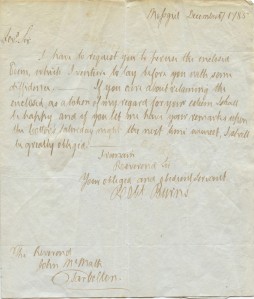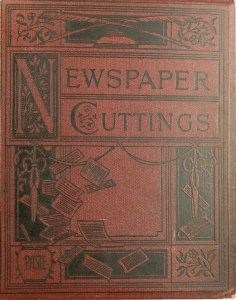Alexander Howland Smith
Forging the Bard
From the moment of Burns’s death in 1796, a hunger to obtain original versions of his works, letters and personal items began. Naturally, this led to a number of unscrupulous individuals creating forgeries, or passing off unconnected objects as having belonged to the Bard. Few were as prolific or notorious however as one Alexander Howland Smith, known as ‘Antique Smith’, a Scottish document forger of the late C19th whose efforts are now collection items in their own right.
Born in 1859, Smith was forging documents in Edinburgh by the 1880s, and began selling his forgeries in 1886. He frequented second hand bookshops, purchasing volumes of old books with blank fly leaves, which he then insisted upon carrying home himself rather than asking for them to be delivered – despite their weight (a practise many bookshop owners found strange!). From these blank fly leaves, Smith forged poems, autographs and historical letters purportedly written by a number of historical figures including Mary Queen of Scots, Walter Scott and Burns himself. He gave his documents an antique appearance by dipping them in weak tea!

Things started to go wrong for Smith when manuscript collector James MacKenzie put some of the letters in his ‘Rillbank Collection’ up for auction in 1891, and the auctioneer himself cast doubt on their authenticity by refusing to verify their provenance. A little while later MacKenzie published a letter, supposedly written by Burns, in the Cumnock Express. After a bit of research, one reader discovered that the recipient of this supposed letter, John Hill, had never actually existed, throwing doubt on the entire Rillbank Collection. MacKenzie later published two ‘Burns’ poems in the same paper, only to discover that one of them had been written when Burns was only 7 by an entirely different poet! Other forgeries were discovered in the collection of an American, who had purchased letters from Edinburgh manuscript collector James Stillie.
By now, word was spreading about the forgeries. In 1892, The Edinburgh Evening Dispatch published an article on the issue, and a reader recognised the handwriting on the facsimiles included as that of Smith, at that time working as chief clerk for a lawyer, Thomas Henry Ferrie. Smith was duly arrested and his trial began on June 26th 1893.

Smith was charged with selling forgeries under false pretences. He was found guilty, but the jury recommended leniency and he was sentenced to 12 months. Experts later said that some of his forgeries were not of particularly high quality – often they were dated after the death of their supposed writer, or created using modern paper or writing tools. It is more than possible that many of those who sold his forgeries on would have been fully aware that they were not genuine. It is unknown exactly how many of ‘Antique’ Smith’s forgeries are still around, but we do know that we have some of them in our collection!